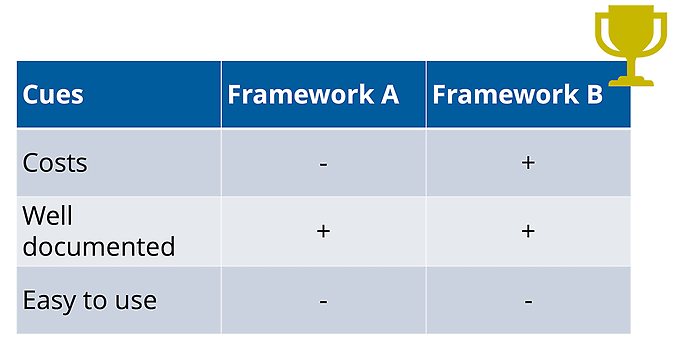28. October 2024 By Milena Fluck and Andy Schmidt
Heuristics as an adaptive toolbox for decision-making under uncertainty
In our first blog post on the topic of "Decision-making under uncertainty ", we looked at various theories, findings and anomalies in the human decision-making process. We therefore recommend that you read this post first.
Decisions accompany our daily work in IT. Be it fundamental architectural decisions, the selection of different technologies or tricky situations in proposal management. In decision theory, a distinction is made between normative and descriptive approaches. Normative approaches are primarily found in economics. They attempt to explain how we can make optimal decisions. Descriptive approaches analyse how people actually make decisions.
With the help of statistics, people have been trying to make optimal decisions for a long time. But no matter how much we calculate with how much data, the world remains a complex and sometimes unpredictable environment in which we have to make decisions every day. Purely rational decisions are based on reason and logic. But we almost always make decisions in the context of limited rationality. Knowledge, time and computing capacity are limited. As a result, people make decisions that are more satisfying than optimal. In order to make a satisfactory decision in uncertain situations in a reasonable amount of time, we have to use techniques beyond complex calculations.
For this purpose, humans have an adaptive toolbox - a set of heuristics - from which they can draw. A heuristic is a process or method that requires less information, calculation and time by ignoring some of the information. In order to optimise the decision with these tools, it is important to choose the right tool for the decision in question. We speak here of ecological rationality. We adapt our decision-making strategy to the environment. Under conditions of bounded rationality due to uncertainty, we fall back on various fast and low-calculation heuristics.
Some of the heuristics that we use in everyday decision-making are presented below
Tallying
Tallying, or the linear unit weighting model, means that you do not estimate weights to estimate a criterion, but simply add up the number of positive indications. Imagine you are comparing two frameworks for your software based on several criteria. You assign a plus or a minus for each criterion and each framework. At the end, all you have to do is add up which of the two frameworks fulfils more criteria.

Take-the-best heuristic
Here, the decision as to which of several options is the best is made solely on the basis of one characteristic or property. You often have a huge selection of sweets in the adesso kitchen. For health reasons, you have decided to eat only one sweet every day. So you are faced with sweets that all score differently according to various criteria: Calorie count per piece, gram count, sugar content per 100 grams, how long you haven't eaten the sweet. You decide on the criterion that is most important to you and choose the overall winner on this basis. If you have decided in favour of the number of grams, the chocolate bar or gummy bear bag with the largest mass in grams wins.
Satisficing
Then we have satisficing. We look for alternatives and choose the first one that exceeds our requirements. Imagine you want to hire a new developer because this position in a project urgently needs to be filled. Instead of looking at all available applicants on the market, we select the first one who is "good enough" and exceeds our requirements. If we were to invite further applicants afterwards, we would no longer be able to justify the time and expense of further interviews, even if an even better candidate could perhaps be found on the market.
Imitate the successful
Each of us has to learn and gain experience from scratch. But not everyone has to make the same mistakes at least once. We observe and learn. With this heuristic, we particularly look at the successful and imitate their behaviour. This is also a driving force in cultural evolution. In order to lead a project to success, we can look at projects from the past and analyse what exactly was done there and what decisions were made that could have been decisive for success.
Tit-for-tat
A well-known example of this is the prisoner's dilemma. It represents a situation in which two parties, who are separated and unable to communicate with each other, have to decide whether or not to co-operate with the other party - in this case the police. The two prisoners are presented with three scenarios and have to decide whether or not to confess to the offence:
- Prisoner 1 remains silent, Prisoner 2 confesses: seven years (Prisoner 1), zero years (Prisoner 2)
- Prisoner 1 confesses, prisoner 2 confesses: five years imprisonment for both
- Prisoner 1 remains silent, prisoner 2 also remains silent: three years imprisonment for both
The highest reward for each party results if both parties co-operate. Only if both parties remain cooperatively silent and both accept the three-year sentence as a minor punishment do both parties make a relatively good deal. This behaviour can also be observed in the commercial market, for example when it comes to tariffs in international relations and business negotiations. It can be advantageous in negotiations with customers or business partners.
Default heuristic
Doing nothing is also a decision. This is what the default heuristic says. If there is a default, you should do nothing. The default is seen as the "safe" alternative and requires no further energy expenditure. This explains, for example, the different organ donation rates in countries where organ donation is the default setting and in countries where you have to take active steps to become a donor. In this context, it is particularly important to set solid company-wide standards that we can fall back on in the event of a default. For example, a standard technology stack. It is important not to default just because you want to avoid decisions or invest time in further research. For example, it can also be disadvantageous to always fall back on the old relational database management system, even though you are not completely satisfied with it and there are now new, cheaper and more convenient solutions on the market that could save you time and money.
Conclusion
Our adaptive toolbox has many more heuristics in store for us. Heuristics are not the second-best solution. Optimisation is not always better. We do not only use heuristics because of limited cognitive resources. People can rely on heuristics for more than just unimportant routine decisions. It's okay to use heuristics for important decisions in our daily work as well. We already do this successfully every day.
You can find more exciting topics from the world of adesso in our previous blog posts.
Also interesting:


